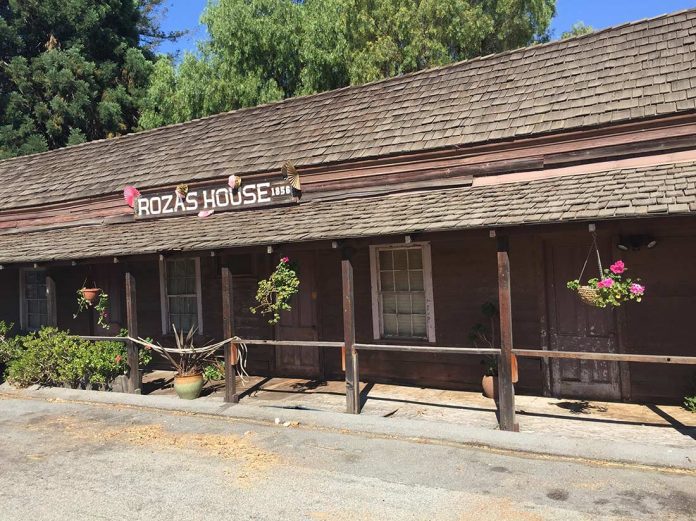
Those who find themselves in downtown San Juan Bautista find themselves to be immersed in preserved historical landmarks and buildings. Though most of the town’s relics are known from California school books or movies, there are others just waiting to tell their stories to daily passersby.
One such enchanting building can be found on the northern end of town, at 31 Polk St. The Rozas House may be missed if visitors on Third Street stop short of perusing past San Juan Bakery & Grocery, but the house’s unique and wooden features can attract any modern eye that spots it.
“This house is like a rockstar,” says current resident and co-owner Bruce Gilsenan. “Every day, even if it’s raining, people stop to take pictures and come looking in the window.”
Much of the building’s intrigue stems from its rare layout and wooden structure.
“The construction is very interesting because it’s ‘board on end’” without the use of studs, says co-owner Shawna Freels, Gilsenan’s sister. “And it has the lath and plaster concept, so there’s no true insulation.”
Built in 1856 by Chilean designer Bartolome Samit, the long, narrow house (made from local redwoods) also features six front-facing doors, as well as an interior courtyard—all part of its original structure, says Freels.
According to the website www.historicwalkingtrail.com, the shape of the Rozas House (“with a long narrow series of rooms, each of which opening onto the street”) is a common mid-19th century California “vernacular form.”
Gilsenan further explains that each of these rooms have interior doors connecting them.
“When I was a kid, I’d get on a skateboard and go all the way down,” he laughs.
Built neither on sand nor rock, the house remains standing on the mudsill foundation it was originally placed on.
“The house has no foundation; there isn’t cement underneath this,” Gilsenan explains. “Right underneath, it’s just dirt.”
Freels recalls having an estate sale on the property five years ago, where close to 200 people attended.
“It really deteriorated the flooring,” she says. “We had a lot of heels that popped through the flooring and dents and stuff.”
Freels posits that other than its construction, its original owners are the most interesting facets of the home.
In 1875, Ambrosio Rozas Sr. purchased the property as a gift for his son, Ambrosio Jr., and his new bride, Emelda Erasma Lugo. The young couple went on to raise 12 children in the home, and remained in the residence throughout their lives.
After Ambrosio Jr. passed away in 1934, Emelda continued to live in the home until 1956, when she moved to San Francisco to live with her daughter. She later passed away at the age of 104.
“Emelda lived in the home for 80 years; it’s a pretty amazing story,” Freels says.
Especially since, as Freels explains, the Rozas matriarch was raised in the convent school at Mission San Juan Bautista after the death of her parents and her aunt.
“After her husband passed, she continued to live in the home and rented out rooms to various people at various times just to make ends meet,” Freels says. “Eventually she opened it up into a little halfway house, a little hotel sort of thing.”
Terry Balz, a Rozas descendant, and her husband, Al, purchased the house in the 1970s, and rented the rooms out to a real estate office, beauty salon, artist studio and boutique.
“Periodically throughout the years, rooms had been rented out for various different things,” Freels adds.
In 1977, Gilsenan’s and Freels’s parents, Ann and James “Scotty” Gilsenan, bought the property from the Balz family and used it as their residence. Scotty placed the home on the National Register of Historic Places in 1984, and lived at the residence until his death in 2012.
Gilsenan and Freels are now co-owners of the property, with Gilsenan residing there.
“I think the house was empty for about a year or so after my dad passed away,” he says. “I moved back here around 2013 or 2014. It was hard at first.”
Rightfully so, as Gilsenan says it holds many memories of his late father.
“I’ll still tell my friends, ‘Hey, let’s go to my dad’s house,’” he says.
The house also spawned a non-profit organization, Rozas House Org., Inc., now in its third year of operation.
“The reasoning behind developing a non-profit is to really to help promote San Juan Bautista’s early California history, retelling of the stories of early California history in San Juan Bautista and, of course, to help preserve our history,” Freels says.
The non-profit, in partnership with San Juan Bautista Historical Society, the City of San Juan Bautista, and the San Juan Bautista Committee created the San Juan Bautista Historic Walking Trail two years ago.
“It’s one of those projects that everyone in San Juan has always talked about—‘We should have plaques, we should have a tour’—and it never came to fruition,” Freels says. “So we pulled together to create this.”
With trail brochures available at the San Juan Bautista Welcome Center, located in the San Juan Bakery & Grocery at 319 Third St., visitors can take a self-guided walking trail of 43 historically significant sites.
Phase two of the project kicked off with a ribbon cutting on April 13 at the new map kiosk next to the San Juan Bakery.
Halina Kleinsmith, who owns Fool’s Gold in San Juan Bautista, says she has used her background in historic preservation as a board member of the Rozas House Org., Inc.
“It’s been my love and my joy to be involved as a board member on Rozas House,” Kleinsmith says.
Kleinsmith is also a volunteer contributor to the Mission Village Voice, and in the March 2019 issue she explains the progress made by the Rozas House Org., Inc.
In addition to providing visitors with a Historic Walking Trail Map, Kleinsmith writes about the installation of “20 bronze plaques on historic Third Street structures [and the creation of] smartphone QR codes for building and project narratives.”
Freels says this form of interaction also helps provide statistics on the town’s tourism data.
“We have people from all over the world who come to San Juan, and we can now see that,” Freels says. “We’ve had about 150,000 hits. It’s amazing how many people are on our website. So we’re just really trying to develop heritage tourism; those are the things that we really want to involve ourselves in, and to help preserve this incredible history we have here.”
For more information on the Rozas House, Rozas House Org., Inc., or the San Juan Bautista Historic Walking Trail, visit rozashouse.org or historicwalkingtrail.com.
“The Days of Wine and Rozas,” a benefit for Rozas House Org., Inc., is set for May 18. For tickets and information, visit tinyurl.com/yyn8cvw6.









